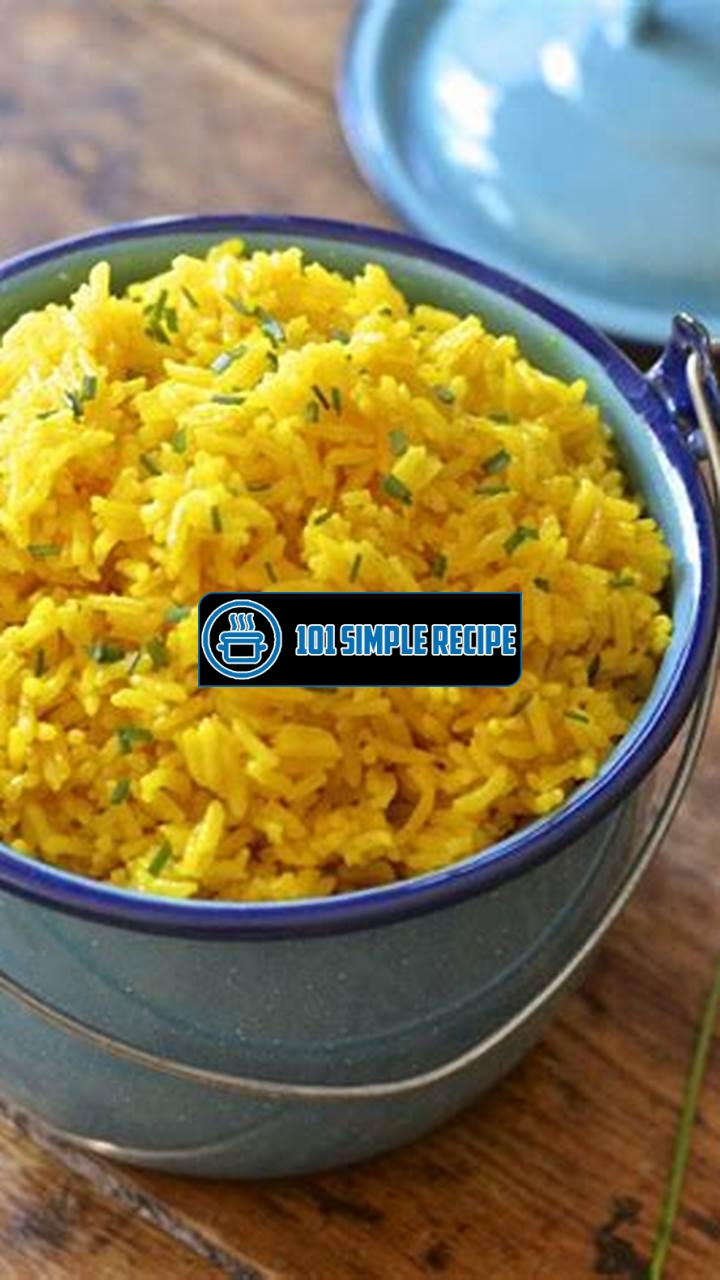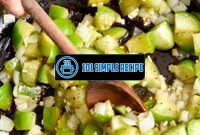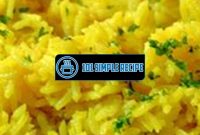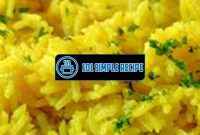Unlocking the Versatility of Yellow Rice

Yellow rice, a vibrant and flavorful dish, holds the key to unlocking a world of culinary possibilities. The golden grains, infused with turmeric or saffron, impart a captivating hue and a distinct aromatic profile. Whether paired with succulent meats, fresh seafood, or an array of vegetables, yellow rice provides a versatile foundation for creating mouthwatering and visually stunning meals. In this article, we will delve into the origins of yellow rice, explore its diverse cultural adaptations, and showcase some exciting recipe ideas that will undoubtedly elevate your dining experience. So grab your apron and prepare to embark on a culinary adventure with yellow rice! ✨
What Makes Yellow Rice Unique?
Yellow rice is a versatile and flavorful type of rice that stands apart from other varieties. Its vibrant yellow color adds a pop of visual appeal to any dish, and its rich and aromatic flavor enhances the overall taste experience. But what exactly makes yellow rice unique? Let’s dive into its distinctive characteristics and explore why it is a favorite choice for many cuisines around the world.
The Origins of Yellow Rice
The origins of yellow rice can be traced back to traditional Asian and Mediterranean cuisines. It has been a staple in countries like India, Thailand, Indonesia, and Spain for centuries. These cultures have mastered the art of creating delicious and flavorful rice dishes, and yellow rice plays a significant role in their culinary traditions.
Yellow rice is often prepared by infusing the grains with a variety of spices and herbs. This infusion not only gives the rice its distinct yellow color but also imparts a unique blend of flavors. The combination of these spices and herbs varies in different regions, resulting in slight variations in taste and aroma.
The Key Ingredient: Turmeric
One of the key ingredients that give yellow rice its vibrant color is turmeric. Turmeric is a spice derived from the Curcuma longa plant, which belongs to the ginger family. It is commonly used in Asian and Middle Eastern cuisines for its earthy flavor and bright yellow color.
Turmeric is not only responsible for the beautiful golden hue of yellow rice but also adds a range of health benefits. It contains a compound called curcumin, which has antioxidant and anti-inflammatory properties. These properties make turmeric a popular choice in natural remedies and have been linked to various health benefits, such as improved digestion and reduced risk of chronic diseases.
The Health Benefits of Yellow Rice
Beyond its appealing color and delicious taste, yellow rice also offers several health benefits. As mentioned earlier, turmeric, the key ingredient in yellow rice, provides anti-inflammatory properties. This can help reduce inflammation in the body and support overall well-being.
Additionally, yellow rice is a good source of carbohydrates, which are essential for providing energy to the body. It also contains fiber, which aids in digestion and promotes a healthy gut. The combination of carbohydrates and fiber makes yellow rice a filling and satisfying choice.
Furthermore, yellow rice is typically low in fat and cholesterol-free. It can be a healthier alternative to other rice varieties that may have higher levels of fat and cholesterol. Incorporating yellow rice into your diet can thus contribute to maintaining a balanced and nutritious eating plan.
In conclusion, yellow rice stands apart from other types of rice due to its unique characteristics. Its origins in Asian and Mediterranean cuisines, the infusion of spices and herbs, and the presence of turmeric as a key ingredient all contribute to its distinct flavor, vibrant color, and health benefits. So next time you’re looking to add a burst of flavor and color to your rice-based dishes, consider the versatility and appeal of yellow rice.
Traditional Dishes with Yellow Rice
Yellow rice is a versatile ingredient that is widely used in traditional dishes from various cultures around the world. Whether it’s the vibrant arroz con pollo from Latin America, the fragrant nasi minyak from Malaysia, or the aromatic saffron rice from India, yellow rice plays a key role in creating these delightful dishes.
Arroz con Pollo: A Latin American Delight
Arroz con pollo, which translates to “rice with chicken” in English, is a classic Latin American dish that brings together the flavors of chicken, vegetables, and yellow rice. This hearty one-pot meal is popular in many Latin American countries, with each region adding its own unique twist to the recipe.
The chicken in arroz con pollo is typically seasoned with a blend of spices, such as cumin, paprika, and garlic powder, to infuse it with rich flavors.
Along with the chicken, various vegetables like bell peppers, peas, and carrots are added to the dish to provide color, texture, and additional nutrients.
The star of the show, of course, is the yellow rice, which not only adds a beautiful hue to the dish but also lends a distinct flavor and aroma that complements the other ingredients perfectly.
Nasi Minyak: A Fragrant Malaysian Dish
Nasi minyak, which means “oily rice” in Malay, is a fragrant rice dish that is often served during special occasions in Malaysia. This aromatic dish is made by cooking basmati rice with a blend of spices and ghee, giving it a rich and luxurious flavor.
The key ingredient in nasi minyak is the yellow rice, which is achieved by cooking the rice with turmeric and saffron, resulting in a vibrant yellow color.
To enhance the aroma, spices like cinnamon, star anise, and cardamom are added to the rice, filling the air with a tantalizing fragrance as it cooks.
Nasi minyak is usually served with various side dishes such as fried chicken, beef rendang, or curry. The combination of the fragrant yellow rice and flavorful accompaniments creates a truly satisfying and memorable dining experience.
Saffron Rice: The Indian Connection
Saffron rice, also known as zafrani pulao, is a popular dish in Indian cuisine that is often served on special occasions like weddings and festivals. This aromatic rice dish gets its vibrant yellow color and distinct flavor from the precious spice, saffron.
Saffron threads, which are derived from the crocus flower, are soaked in warm milk or water, releasing their vibrant yellow hue and delicate aroma.
The yellow rice is then cooked with fragrant spices like cardamom, cloves, and cinnamon, taking the flavors to a whole new level.
Saffron rice is typically garnished with fried onions, raisins, and nuts like almonds and cashews, adding crunch and texture to the dish.
Whether it’s a festive celebration or a special gathering, saffron rice brings a touch of elegance and indulgence to any meal. The combination of the golden hues and the tantalizing aroma makes it a feast for both the eyes and the taste buds.
In conclusion, yellow rice is a versatile ingredient that adds color, flavor, and fragrance to traditional dishes from various cultures. Whether it’s the Latin American arroz con pollo, the Malaysian nasi minyak, or the Indian saffron rice, yellow rice plays a significant role in elevating these dishes to new heights. So why not explore the world of yellow rice and unlock its versatility in your own cooking?
To learn more about yellow rice and its uses, check out our Aunt Annie’s Pretzel Recipe! This delicious recipe uses yellow rice as a main ingredient to make tasty pretzels. Give it a try and see how versatile yellow rice can be!
Yellow Rice in International Cuisine
Yellow rice, known for its vibrant color and subtle flavors, has become a staple in many international cuisines. This versatile ingredient plays a significant role in diverse dishes beyond traditional recipes. From Mediterranean-inspired pilaf and paella to aromatic curries and even sushi rolls, yellow rice brings a vibrant twist to a variety of international dishes.
Pilaf and Paella: Mediterranean Influences
In Mediterranean cuisines, yellow rice is commonly used in two iconic dishes – pilaf and paella. Both dishes utilize the beautiful yellow hue of the rice to create visually appealing and flavorful meals.
Pilaf: In pilaf, the yellow rice is usually cooked with a mixture of aromatic spices, vegetables, and sometimes even meats. The result is a fragrant and richly colored rice dish that pairs perfectly with grilled meats or roasted vegetables.
Paella: Paella, a traditional Spanish rice dish, also features yellow rice as its base. The rice is typically flavored with saffron, a spice that gives it a distinctive yellow color and a unique taste. Mixed with seafood, chicken, or vegetables, paella becomes a crowd-pleasing medley of flavors and textures.
Curries: The Aromatic Blend
Across various Asian cuisines, yellow rice is often used in curry dishes to add both color and flavor. The combination of aromatic spices and the vibrant yellow rice creates a delightful and aromatic blend.
Indian Curries: In Indian cuisine, yellow rice, also known as “yellow pulao,” is commonly cooked with fragrant spices like turmeric, cumin, and cardamom. This fragrant rice pairs well with rich and spicy curries, providing a mild and soothing contrast to the fiery flavors.
Thai Curries: Similarly, in Thai cuisine, yellow rice is an integral part of many curry dishes. The fluffy and flavorful rice complements the spiciness of Thai curries, balancing the heat with its mild and slightly nutty taste. ️
Sushi Rolls: A Vibrant Twist
Yellow rice brings an exciting twist to the world of sushi, where traditional white rice is typically used. The bright yellow color instantly catches the eye and adds a vibrant touch to sushi rolls.
California Roll: In American sushi rolls like the California roll, yellow rice is sometimes used as a substitute for the traditional white rice. The subtle flavors of the yellow rice blend harmoniously with the crab, avocado, and cucumber, creating a visually appealing and delicious sushi option.
Sushi Burrito: In sushi burritos, a fusion of sushi and burrito, yellow rice is often an essential component. The vibrant yellow color creates a striking contrast against the fresh vegetables and seafood, making each sushi burrito a colorful and fulfilling meal.
In conclusion, the versatility of yellow rice shines in international cuisine. From Mediterranean dishes like pilaf and paella, to aromatic curries, and even sushi rolls, yellow rice adds a vibrant twist to diverse recipes. Its visually appealing color and delicate flavors make it a delightful addition to any dish. So, the next time you’re in the kitchen, consider incorporating yellow rice to unlock a world of flavors.
For a refreshing and exotic beverage that incorporates yellow rice, try our Coconut Yellow Rice Drink Recipe! This beverage combines the flavors of coconut and yellow rice to create a unique and delicious drink. It’s a great way to enjoy yellow rice in a different form.
Yellow Rice as a Healthy Alternative
Discover why yellow rice is not only delicious but also a nutritious choice to incorporate into a balanced diet.
Nutritional Profile of Yellow Rice
Yellow rice is a popular dish in many cultures and is often used as a staple food. It is made by combining rice with turmeric, which gives it the distinctive yellow color. This vibrant dish is not only visually pleasing but also offers a wide range of health benefits.
Nutrients:
Yellow rice is a good source of essential nutrients that are important for maintaining good health. It is rich in carbohydrates, which provide energy to the body. It also contains dietary fiber, which aids in digestion and helps to keep you feeling fuller for longer periods.
In addition, yellow rice is a good source of various vitamins and minerals. It contains vitamin C, which is essential for a healthy immune system. It also provides significant amounts of vitamin B6, which supports brain health, and potassium, which is important for maintaining healthy blood pressure levels.
Antioxidant Properties:
Turmeric, the main ingredient in yellow rice, contains a compound called curcumin, which has powerful antioxidant properties. Antioxidants help to protect the body against damage from free radicals, which can cause chronic diseases such as heart disease and cancer.
By incorporating yellow rice into your diet, you can boost your antioxidant intake and potentially reduce the risk of developing these diseases.
Benefits for Digestive Health
In addition to being a nutritious dish, yellow rice also offers various benefits for digestive health. The turmeric used to make yellow rice contains an active compound called curcumin, which has been shown to have anti-inflammatory and antimicrobial properties.
These properties can help alleviate symptoms of digestive disorders such as irritable bowel syndrome (IBS) and Crohn’s disease. The anti-inflammatory effects of curcumin can also help to reduce inflammation in the gastrointestinal tract and promote healthy digestion.
Improved Digestion:
Yellow rice is rich in dietary fiber, which is essential for healthy digestion. Fiber adds bulk to the stool and helps to prevent constipation. It also promotes the growth of beneficial gut bacteria, which play a crucial role in maintaining a healthy digestive system.
Incorporating yellow rice into your diet can help regulate bowel movements and promote regularity, ensuring optimal digestive health.
Enhancing Immunity with Turmeric
Turmeric, the key ingredient in yellow rice, has long been used for its medicinal properties. It contains a compound called curcumin, which has been shown to have immune-boosting effects.
Curcumin stimulates the production of various immune cells in the body, enhancing the overall immune response. This can help protect against infections and promote general well-being.
Anti-inflammatory Benefits:
In addition to its immune-boosting properties, curcumin also has potent anti-inflammatory effects. Chronic inflammation is associated with many health problems, including autoimmune diseases and chronic pain conditions.
By incorporating yellow rice into your diet, you can help reduce inflammation in the body and potentially improve overall health.
Final Thoughts
Yellow rice is a versatile and nutritious dish that offers a range of health benefits, including improved digestion, enhanced immunity, and antioxidant properties. Including this vibrant dish in your diet can be a delicious way to incorporate more healthy ingredients into your meals and support your overall well-being.
So why not give yellow rice a try? Your taste buds and your health will thank you!
If you’re looking for a unique and flavorful dish that uses yellow rice, our Yellow Rice Stuffed Bell Peppers Recipe is perfect for you! These stuffed bell peppers are filled with a delicious mixture of yellow rice and various vegetables, creating a healthy and satisfying meal.
Creative Uses for Leftover Yellow Rice
When it comes to repurposing leftover yellow rice, the possibilities are endless. Not only does it help minimize food waste, but it also allows you to create delicious and inventive meals that will impress both your taste buds and your family. Whether you have a small amount or a large batch of yellow rice left over, here are a few creative ideas to inspire you:
1. Yellow Rice Stuffed Peppers
Transform your leftover yellow rice into a flavorful filling for stuffed peppers. Cut the tops off the peppers, remove the seeds and membranes, and fill them with a mixture of yellow rice, cooked ground meat, vegetables, and your favorite spices. Bake them in the oven until the peppers are tender and the filling is heated through. The vibrant colors of the peppers combined with the aromatic yellow rice will make for a visually appealing and tasty dish. ️
2. Yellow Rice Frittata
A frittata is a versatile dish that works well for breakfast, brunch, or even a quick dinner. By adding your leftover yellow rice to the mix, you can create a unique and flavorful twist. Simply whisk some eggs in a bowl, add the yellow rice, cooked vegetables, and cheese, and then cook the mixture in a skillet until it sets. The result is a fluffy and hearty frittata with a delightful golden hue. It’s a great way to use up leftovers while enjoying a protein-packed meal.
3. Yellow Rice Buddha Bowl
A Buddha bowl is a bowl filled with a variety of nutritious ingredients, all arranged in an aesthetically pleasing manner. Yellow rice can serve as a fantastic base for a Buddha bowl, providing both flavor and substance. Top your yellow rice with cooked or raw vegetables, protein of your choice (such as grilled chicken or tofu), and some delicious dressings or sauces. This colorful and well-balanced meal is not only visually appealing but also packed with different textures and flavors. It’s a great way to elevate your leftovers into a wholesome and satisfying dish.
4. Yellow Rice Salad
If you’re in the mood for a refreshing and light meal, turning your leftover yellow rice into a salad is a fantastic option. Simply combine the rice with fresh vegetables, such as cucumbers, cherry tomatoes, and bell peppers. Add some protein, like grilled shrimp or shredded chicken, and drizzle a zesty dressing over the top. You can get creative with your flavor combinations, adding herbs and spices that complement the yellow rice. This vibrant and nutritious salad is perfect for a quick lunch or a summer gathering.
5. Yellow Rice Stuffed Tomatoes
One unique way to use up your leftover yellow rice is by stuffing ripe tomatoes with it. Cut the tops off the tomatoes and carefully scoop out the flesh and seeds. Fill the hollowed-out tomatoes with a mixture of yellow rice, cooked ground beef, onions, and herbs. Bake them in the oven until the tomatoes are soft and the filling is heated through. This dish not only looks impressive but also offers a delightful combination of flavors and textures. It’s a great way to add a touch of creativity to your meals.
As you can see, there are plenty of creative uses for leftover yellow rice. From stuffed peppers and frittatas to Buddha bowls and stuffed tomatoes, incorporating this versatile ingredient into your meals can elevate your leftovers into something delicious and exciting. Don’t let your yellow rice go to waste – turn it into a culinary masterpiece!
Thank you for taking the time to read this article about what yellow rice is used for. We hope that it has provided you with valuable information and insights into this flavorful dish. Yellow rice has a rich history and is widely enjoyed for its vibrant color and aromatic flavors. Whether you use it as a side dish, in a main course, or as a base for other dishes, yellow rice is sure to add a burst of color and flavor to your meals. We encourage you to experiment with different ingredients and recipes to create your own delicious versions of yellow rice. Don’t forget to visit our website again for more exciting articles and recipes. Happy cooking!
Frequently Asked Questions
Here are some frequently asked questions about yellow rice:
| No. | Questions | Answers |
|---|---|---|
| 1. | What is yellow rice used for? | Yellow rice is used as a flavorful and colorful side dish or as a base for other dishes. It can be paired with various proteins, vegetables, and sauces to create a complete and satisfying meal. |
| 2. | How is yellow rice made? | Yellow rice is made by cooking rice with various ingredients such as turmeric, saffron, or annatto seeds, which give it its signature yellow color. Additional seasonings and spices can be added to enhance the flavor. |
| 3. | Can I customize yellow rice? | Absolutely! Yellow rice can be customized to suit your taste preferences. You can add vegetables, herbs, and spices to create different flavor profiles. It is a versatile dish that can be adapted to various cuisines. |
| 4. | What are some popular dishes that use yellow rice? | Some popular dishes that use yellow rice include paella, arroz con pollo, and biryani. These dishes combine yellow rice with various proteins, vegetables, and spices to create a complete and flavorful meal. |
| 5. | Is yellow rice healthy? | Yellow rice can be a healthy and nutritious choice when prepared with wholesome ingredients. It is a good source of carbohydrates and can be paired with lean proteins and vegetables for a balanced meal. |
| 6. | Where can I find yellow rice? | Yellow rice can be found in the rice or ethnic section of most grocery stores. It is also commonly available in online grocery platforms. Alternatively, you can make yellow rice from scratch using simple ingredients. |
Discover the Versatility of Yellow Rice
In conclusion, yellow rice is a versatile and vibrant dish that can be enjoyed in various ways. Whether you use it as a side dish, as part of a main course, or as a base for other dishes, yellow rice adds color, flavor, and excitement to your meals. Its rich history and cultural significance make it a popular choice among food enthusiasts around the world. So go ahead, get creative in the kitchen, and explore the possibilities of yellow rice. Thank you for reading, and we look forward to sharing more exciting recipes and culinary adventures with you in the future. Stay tuned!
Jump to Recipe
Yellow Rice with Vegetables

A delicious and colorful rice dish that is perfect as a side or main course.
- 2 cups long-grain rice
- 1 tablespoon olive oil
- 1 onion (diced)
- 2 cloves garlic (minced)
- 1 red bell pepper (diced)
- 1 yellow bell pepper (diced)
- 1 zucchini (diced)
- 1 cup frozen peas
- 1 teaspoon ground turmeric
- 1/2 teaspoon ground cumin
- 1/2 teaspoon paprika
- Salt and pepper to taste
- 3 cups vegetable broth
- In a large pot, heat the olive oil over medium heat. Add the onion and garlic, and cook until softened.
- Add the bell peppers, zucchini, and frozen peas to the pot. Cook for 5 minutes, or until the vegetables are tender.
- Stir in the ground turmeric, cumin, paprika, salt, and pepper. Cook for an additional 2 minutes, until the spices are fragrant.
- Pour in the vegetable broth and bring to a boil. Add the rice, reduce the heat to low, cover, and simmer for 20 minutes, or until the rice is cooked and the liquid is absorbed.
- Fluff the rice with a fork and serve hot. Enjoy!






